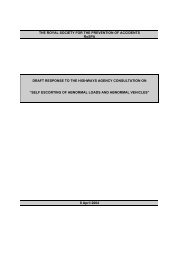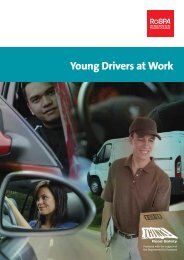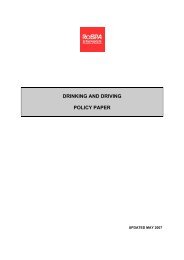Home safety key issues - RoSPA
Home safety key issues - RoSPA
Home safety key issues - RoSPA
You also want an ePaper? Increase the reach of your titles
YUMPU automatically turns print PDFs into web optimized ePapers that Google loves.
11<br />
Safety issue<br />
Delivering Accident Prevention<br />
at local level in the new public<br />
health system<br />
Part 2: Accident prevention in practice<br />
Raise awareness<br />
Fact Sheet <strong>Home</strong> <strong>safety</strong> <strong>key</strong> <strong>issues</strong><br />
Education<br />
Preventative measures<br />
Partnership working<br />
In partnership with:<br />
Reduced Risk of Injury<br />
Accident Prevention Handbook Part 2: <strong>Home</strong> Safety Fact Sheet
2<br />
Delivering accident prevention at local<br />
level in the new public health system<br />
Accident prevention in practice<br />
Part 2<br />
HS1<br />
FACT SHEET: <strong>Home</strong> <strong>safety</strong> <strong>key</strong> <strong>issues</strong><br />
This section provides a summary of the scale of the problem of accidents at home, the costs, who is most at risk and when and where<br />
accidents happen. For more detailed information on causes and prevention of accidents visit www.rospa.com/home<strong>safety</strong>.<br />
Almost everyone has a home and is entitled to feel safe and secure in it. Unfortunately, it is also the place where accidents are most<br />
likely to happen.<br />
Every day in the UK at least 13 people die as the result of an accident at home and just under 8,000 seek medical treatment.<br />
In 2010–2011, 5,000 people in the UK died as the result of an accident at home, compared with 1,901 on the road. 1,2,3<br />
It is estimated that more than 2 million people seek medical treatment at an accident and emergency department for treatment for a<br />
home accident . 4<br />
Why do so many people have accidents at home?<br />
People spend more time at home than anywhere else, particularly the very young and the very old. The home is a complex place with<br />
many potential hazards in every room. Cookers, fires, stairs, windows, cleaning materials, medicines, alcohol, knives and hot water are<br />
just some of the items which can be hazardous, if not used correctly. Many hazardous activities are also carried out at home – climbing<br />
stairs, cooking, carrying hot items, ironing and DIY are just some of the activities, which can result in accidents and injuries.<br />
How much do home accidents cost?<br />
<strong>RoSPA</strong> recently commissioned research from the Transport Research Laboratory (TRL) 5 to look into the cost of home accidents. Its<br />
findings were shocking: the total annual cost of home accident casualties who are treated for their injuries at hospital – around<br />
2.7million people each year – is estimated to be £45.63billion (£45,630million), based on an average cost of £16,900 per victim.<br />
This figure does not include the cost of home accident deaths, which number in excess of 5,000 every year, and for which the cost per<br />
fatality is estimated at £1.61million. And it does not include the cost of people who seek GP treatment after a home accident. So, in fact,<br />
the true cost to society of accidents at home is likely to be far higher.<br />
Who is most at risk?<br />
l Children under the age of five and people over 65 (particularly those over 75) are most likely to have an accident at home<br />
l <strong>Home</strong> accidents are the most common cause of death in children over one year of age. Every year they leave many thousands<br />
permanently disabled or disfigured<br />
l More than one million children under the age of 15 experience accidents in and around the home every year, for which they are<br />
taken to accident and emergency units. Many more are treated by GPs and by parents and carers<br />
l The children most at risk from a home accident are the 0–4 years age group. Falls account for the majority of non-fatal accidents<br />
while the highest number of deaths are due to fire. Most of these accidents are preventable through increased awareness,<br />
improvements in the home environment and greater product <strong>safety</strong><br />
l More women than men over the age of 65 die as the result of an accident in the home<br />
l Every year around 120 children under 14 die as the result of an accident in the home<br />
l Boys have more accidents than girls<br />
l Childhood injuries are closely linked with social deprivation. Children from poorer backgrounds are five times more likely to die as a<br />
result of an accident than children from better off families – and the gap is widening 6<br />
Accident Prevention Handbook Part 2: <strong>Home</strong> Safety Fact Sheet
33<br />
l Those over 65 years of age are the other group most at risk, suffering both the highest mortality rate and the most severe injuries.<br />
An estimated 500,000 people aged over 65 attend accident and emergency departments as the result of a home<br />
accident each year 6<br />
l The majority of accidents in the older age groups involve females rather than males<br />
l Many of the fatal and non-fatal accidents to older people are attributable wholly or in part to frailty and failing health. This can lead<br />
to failure or slowness to see and avoid risks. By drawing the attention of older people and their carers to danger spots and unsafe<br />
habits then accidents can be reduced.<br />
What type of accidents happen?<br />
l Falls are the most common accidents, which can cause serious injury at any time of life. 55% of accidental injuries in the home involve<br />
falls. Almost three-quarters of falls among the 65-and-over age group result in arm, leg and shoulder injuries. Older people are<br />
also more likely to injure more than one part of their body, with 25% of falls causing injury to more than one part of the body,<br />
compared to an average 16% among all age groups. One in every five falls among women aged 55 and over results in a fracture or<br />
fractures requiring hospital treatment.<br />
l Approximately 1,500 people aged over 75 die annually as the result of a fall. Although most falls do not result in a serious injury,<br />
being unable to get up exposes the faller to the risk of hypothermia and pressure sores<br />
l Around 25,000 under-5s attend A&E departments each year after being accidentally poisoned<br />
l 26,000 under-5s are burnt or scalded in the home every year. A hot drink can still scald a small child up to 15 minutes after it<br />
is made<br />
Where do accidents happen?<br />
l More accidents happen in the lounge/living room than anywhere else in the home.<br />
l Every year more than 4,200 children are involved in falls on the stairs and 4,000 children under the age of 15 are injured falling<br />
from windows<br />
l The most serious accidents involving older people usually happen on the stairs or in the kitchen. The bedroom and the living room<br />
are the most common locations for accidents in general<br />
l The largest proportion of accidents are falls from stairs or steps with over 60% of deaths resulting from accidents on stairs.<br />
15% of falls are from a chair or out of bed (on two levels) and a similar number are caused by a slip or trip on the same level, e.g. falling<br />
over a mat or a rug.<br />
When do accidents happen?<br />
l Most accidents happen between late afternoon and early evening, in the summer, during school holidays and at weekends<br />
l Factors such as stress, death in the family, chronic illness, homelessness or moving home increase the likelihood of the child having<br />
an accident<br />
l Some happen when the usual routine is changed or when people are in a hurry<br />
l Distractions and inadequate supervision are often the cause of accidents<br />
l Poor housing and overcrowded conditions lead to an increased numbers of accidents.<br />
l Some accidents are caused by lack of familiarity with surroundings, for example, when visiting friends or relatives, or in<br />
holiday accommodation.<br />
Accident Prevention Handbook Part 2: <strong>Home</strong> Safety Fact Sheet
4<br />
Preventing accidents in the home<br />
“A safe, secure and sustainable environment is a prerequisite<br />
for a healthy nation.” 5<br />
A combination of factors is required:<br />
Environment<br />
Improvement in planning and design results in safer homes and leisure areas. Adaptations such as fireguards and <strong>safety</strong> gates help to<br />
make the home environment safer.<br />
Education<br />
This involves increasing the awareness of the risk of accidents in a variety of settings and providing information on ways of minimising<br />
these risks.<br />
Empowerment<br />
Local consultation and community involvement can generate a strong sense of commitment and ownership. Accident<br />
prevention initiatives, which have been influenced by the community, are more likely to reflect local need and therefore<br />
encourage greater commitment.<br />
Enforcement<br />
There is legislation which relates to child <strong>safety</strong>. These regulations ensure that the products we buy meet a reasonable level of <strong>safety</strong><br />
performance and that new dwellings meet an acceptable level of <strong>safety</strong>.<br />
References<br />
Combined data from:<br />
1. Office for National Statistics: Mortality Statistics: Deaths Registered in 2011 (Series DR), table 7. London: ONS, 2012. http://www.ons.<br />
gov.uk/ons/publications/re-reference-tables.html?edition=tcm%3A77-277727 (accessed May 2013).<br />
2. General Register Office for Scotland: Vital Events Reference Tables 2011, table 6.2. Edinburgh: GROS, 2012. http://www.gro-scotland.<br />
gov.uk/files2/stats/ve-reftables-2011/ve-2011-t6.2.pdf (accessed May 2013).<br />
3. Northern Ireland Statistics and Research Agency. Registrar General Northern Ireland Annual Report 2011, table 6.2. Belfast: DFP, 2012.<br />
http://www.nisra.gov.uk/demography/default.asp100.htm (accessed May 2013).<br />
4. Department of Health. Our healthier nation: a contract for health. Consultation Paper London: Stationery Office, 1998. 94pp.<br />
5. Transport Research Laboratory. Re-evaluation of home accidents (report PPR 483). Bracknell” IHS, 2010. http://www.rospa.com/<br />
home<strong>safety</strong>/Info/re-evaluation.pdf (accessed May 2013).<br />
6. Department for Trade and Industry. 24th (final) report of the <strong>Home</strong> and Leisure Accident Surveillance System: 2000,2001 and 2002<br />
data. London: DTI, 2003. http://www.hassandlass.org.uk/reports/2000_2002.pdf (accessed May 2013).<br />
Accident Prevention Handbook Part 2: <strong>Home</strong> Safety Fact Sheet
55<br />
<strong>RoSPA</strong> Headquarters:<br />
28 Calthorpe Road,<br />
Edgbaston,<br />
Birmingham B15 1RP<br />
Telephone: +44 (0)121 248 2000<br />
Fax: +44 (0)121 248 2001<br />
Registered Charity No. 207823<br />
VAT Registration No. 655 131649<br />
www.rospa.com<br />
In partnership with:<br />
© The Royal Society for the Prevention of Accidents<br />
Accident Prevention Handbook Part 2: <strong>Home</strong> Safety Fact Sheet

















